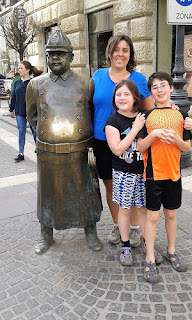From Athens we made our way to
Budapest. We arrived at night and took public transportation to get
from the airport into the center of Pest. It always felt safe. There
were a lot of young people in the metro (the subway) and walking in
the streets. A friendly young woman even helped us find the right
street to walk along on our way to the apartment in which we were
staying.
 |
| The not-so-blue Danube |
Budapest is two cities, Buda and Pest,
that united some time ago. They are separated by the Danube River.
You know the famous waltz, the Blue Danube? Well there are a few
ironies there. First, it is a major tribute to Vienna, though the
Danube doesn't flow through the center of Vienna, but more along its
outskirts. (Today, Vienna has grown to encompass the river, but when
Strauss wrote the piece, the city wasn't so big yet.) But it does go
right through the heart of Budapest.
Another irony, the Danube isn't blue.
(There's actually a Spike Jones song all about this fact.) And it
wasn't blue in 1866 when the waltz was written. I learned that the
song has lyrics. Two sets of lyrics. The first set was written by the
poet of Vienna's Choral Association and it makes fun of Vienna and
the fact that the Danube isn't blue. The second set is more properly
patriotic and is called “Danube so blue”, so it ignores the basic
greenness of the river.
But back from the tangent of music
history to city present.
 |
| Do you think people cover their heads when they enter the door |
Budapest is interesting in its
architecture. First, it is quite varied and often beautiful. Second,
you will sometimes see something strikingly modern next to something
intricately old. Consistency is not the goal in Budapest, but
spectacle may be.
 |
| I love the bulbs at the tops |
At times as you walk through Budapest
you happen upon fascinating street art.
 |
| Under arrest for... well, you decide the crime |
In this picture,
you see an escort by the guard. But it's bad news. We learned that
the guard wears his sword on his left side, so he pulls it out with
his right hand. If he has you walk on his right, that means you are
an honored personage that he is escorting, because he can more easily
defend you with his sword. But if you are walking on his left, it
probably means you're in trouble. Also, notice the reflection of the
sun on his bulging gut? He really has a fire in his belly.
 |
| Elephants. In hats. |
 |
| I'm not playing with angles. This sculpture truly goes up the wall. |
Budapest has held onto much of its
heritage. The area was founded by seven Magyar tribes who sailed up
the Danube. And though Hungary has been controlled by the Prussians,
Austrians, Germans, and Soviets over the centuries, the people still
hold onto their language and identity as Magyars.
 |
| Part of Fisherman's Bastion |
Fisherman's Bastion is built upon
Castle Hill, a high hill on the Buda side that overlooks the Danube.
The long structure has seven peaked roofs, one for each of the Magyar
tribes. I also found statues of six of the great chiefs of those
tribes. I couldn't find the seventh, nor any explanation as to why
there were only six. But notice the individuality of these six men.
One of them even has a raven on his shoulders.
 |
| We are chiefs |
 |
| So are we |
The Hungarians still use their
beautiful castles, now for governmental buildings. Some have needed
to be rebuilt as they were destroyed in wars, but others have
survived reasonably unscathed.
 |
| Palatial, right? |
Before World War II, Hungary had a rich
Jewish tradition. Even today, there is a large Jewish District in
Pest, though far fewer Jews live there. During World War II, Hungary
did constrict Jews to certain districts, to ghettos. There was a
great feeling of antisemitism. However, the Hungarian government
resisted Germany's attempts to deport the Jews from Hungary to
concentration camps for quite some time. Eventually when Germany
fully occupied Hungary, those Jews were deported and many killed.
In the Jewish district there is a
striking monument to those deported and killed in the form of a
sculpted willow tree.
 |
| The Willow Sculpture Monument |
The food in Hungary is delicious. Of
course, you have to try goulash, which is a soup. We didn't realize
this. It surprised us. But we tried many other dishes. Carver, who is
quite a fan of fried and roasted chicken, declared Hungary as one of
the great chicken making nations of the Earth. But we ate many other
dishes such as sorrel stew and sirloin strips to name some that I can
name. However, one of our favorite meals came at a hole in the wall
place in which we didn't know the name of anything we were ordering.
We just pointed at the dish we wanted, paid, and said kozy (which is
short for koszonom or thank you.) But the food, full of meat and
vegetables was incredible. And filling!
Overall, Budapest is clean, friendly,
lively, but not crowded, well laid out, and easy to get around. It
has large spaces for work and for play. I enjoyed it immensely and I
was quite comfortable there.
 |
| Could you play both sports at once? |
Plus, the Magyars are highly efficient
and practical. Check out what we saw in a local park. Combination
basketball/soccer. Who wouldn't love this place?
No comments:
Post a Comment